Fr Ted Burns is a retired priest of the Melbourne Archdiocese. He has had a long association with Ryder-Cheshire and was instrumental many years ago in recruiting our current RCA President, Peter Newton AO. Fr Burns recently visited Klibur Domin in company with Peter. He is the author of this article which is appearing in the Catholic magazine Annals Australasia and the text is reproduced here with kind permission of
Fr Burns and the publisher.
SHARED LOVE IN EAST TIMOR
RYDER-CHESHIRE IN ACTION ON AUSTRALIA’S DOORSTEP
By Fr. Ted Burns PE
It’s not every day that a priest (especially one in his late 70s) gets such a sweet smile from a young lady. It happened to me recently at a small village in Ermera province, in the rugged mountains of Timor-Leste, better-known as East Timor.
The lady concerned was about 10 months old. As she beamed at me from her mother’s arms, I realized, as her tiny face lit up, that she had virtually no upper lip. My immediate reaction was resolving to find help for her. Such cases are not unusual.
On this visit to East Timor, I had joined the mobile unit of a Community Based Rehabilitation team from Klibur Domin (KD) a Ryder-Cheshire (RCA) initiative sponsored by Australians and New Zealanders, and operated by about 40 local Timorese from their base at Tibar, 17 km west of Dili.
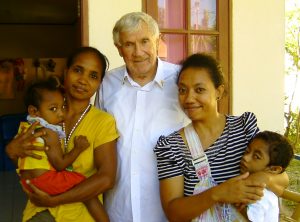
Fr Burns with mothers and young patients
Klibur Domin is Timorese for Shared Love, and the Mobile Rehab team is just one arm of this wonderfully effective outfit. There is also a Mobile TB team. It too travels to remote villages, diagnosing and treating sufferers. Timor has one of the highest rates of TB in the world, and literally hundreds have been treated, thanks to the Clinic at KD.
This facility is one of the country’s major centres, for the treatment of TB, and for the training of local people as laboratory technicians who play a major role in the treatment, and in the follow-up process.
A recently acquired GeneXpert machine provides fast and accurate diagnosis of patients. This has made a dramatic difference as, previously, samples had to be sent to Australia for analysis, and took many weeks to finalise.
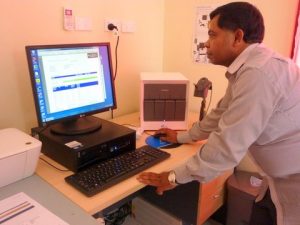
Joaquim Soares (KD Director) and the GeneXpert Machine
Klibur Domin is just 15 years old and, in this time, has established, in addition to the Mobile Teams, a Low-Care Hospital, a Home for the elderly, a Respite Centre, and a Rehabilitation Centre. It has its own TB Hospital, with separate clinic, and buildings for administration.
These achievements, and many more, have resulted from dedicated planning, generous donations from a number of sources, and wonderful ‘hands on’ help from Rotary.
A constant stream of self-funded volunteers, over two-hundred so far (mostly from Australia), have contributed enormously to the day-to-day functioning of Klibur Domin. An example of such a volunteer is Trish McDonell, a former RAAF Air Traffic Controller. Her contribution to KD as Home Manager, and her periods of service (thirteen so far) has to be measured in years.
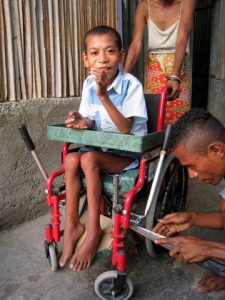
Running repairs to wheelchair in village
‘Relief of Suffering’ was the goal of Sue Ryder and Leonard Cheshire, the two extraordinary individuals who at first independently, and later together, founded institutions for this purpose world wide.
It all began in England after WWII, and later spread into many other countries, at one time numbering more than 350 Homes.
Both Cheshire and Ryder were regarded as heroes: she for her work, beginning as a teenager in Special Operations in wartime England, and after WWII in Poland, and he – Leonard Cheshire V.C. – was one of the most celebrated (and decorated) of British servicemen. He was leader of the famous 617 Squadron (Dambusters, Pathfinders etc).
Cheshire died in 1992, and Sue Ryder in 2001. Their enthusiasm lives on in those they inspired.
The alliance between the Royal Airforce and the RAAF was forged during WWII, though when I first heard Leonard Cheshire speak in the early 60s, the topic was not about our history. Cheshire’s compassion, ambitious plans and ideas for the relief of suffering made a profound impression on me, and on all who heard him.
I was quite overwhelmed by his faith and dedication, and noted that he was not remotely interested in talking about his wartime achievements. When asked what motivated him, he made an interesting point. It wasn’t, as has often been suggested, post-war regrets or guilt. It was the Gospel, which he rediscovered during a serious post-war illness. Quite independently Leonard Cheshire and Sue Ryder found their seperate ways into the Catholic Church. They married in 1959.
As a seminarian, and later as a young priest I supported Ryder-Cheshire, and encouraged others to do so. The opportunities improved significantly when I was appointed Chaplain to the RAAF Specialist Reserve. I had a ready-made audience as, for most RAAF personnel, the name Cheshire VC, rang a loud and familiar bell.
It happened that my favourite subject also appealed to the Commanding Officer of the unit where I worked – Air Commodore Peter Newton AO. When he retired after thirty-seven years in the RAAF, he became National President of Ryder-Cheshire Australia. He was going to need all the administrative skills that he brought with him. Appalled by the situation in East Timor, Peter looked for ways Ryder-Cheshire could help relieve the suffering.
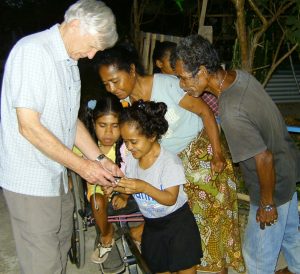
Peter Newton with clients at Klibur Domin
After twenty-four brutal years ruling East Timor (and after up to 200,000 deaths), the Indonesian Government reluctantly agreed to a Referendum on Independence for the East Timorese. Overwhelmingly the locals chose Independence, and paid a very high price for so doing. A local anti- independence Militia, supported and equipped by Indonesia, launched a campaign of murder, rape, and plunder. Up to eighty per cent of buildings were burnt or destroyed. Australian forces, part of an International force (INTERFET) led by General (now Sir Peter) Cosgrove, did eventually restore order, but Dili (pop.190,000) and its environs was a smouldering mess.
Many sites were considered and eventually a severely damaged, but still somehow functioning home for the disabled was offered to RCA. It came as a package deal, with staff, about twenty inmates and eighteen buildings, all of which had been stripped of fittings and vandalised.
That this shambles could ever have been made into the wonderful facility it has become, is a triumph; a tribute to Peter Newton, his helpers and donors, and the series of tradesmen-visits organised by ever helpful Rotary.
In a little over twelve months Klibur Domin opened for business in September 2000.
Flourishing with its Indigenous staff of about 40, Klibur Domin is run economically and efficiently. Some young residents (with manageable disabilities) live in the Respite Centre and attend the local school run by Franciscan nuns. People come and live-in for Rehab and TB follow-up. The mobile units visit remote areas regularly to diagnose and treat patients. Some of the older cottages are being rebuilt, locals in need of dialysis are regularly transported to Dili, and a dental unit is in the planning stages.
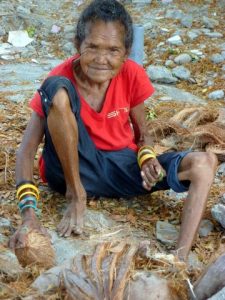
An elderly resident of Klibur Domin
For years when fundraising, I have been able to emphasise some issues that meet with universal approval: Ryder-Cheshire has no paid executives or staff, no travel, or other allowances, no costly advertising. Highly capable people do the managing, and when they visit East Timor, they pay their own way. Volunteers, some of whom spend up to two years in East Timor, do so gratis.
All money raised goes where the donors want it to go, for the relief of suffering. Every time, without exception, when I appeal for financial support, donors say that they are motivated by seeing a worthy cause to which all funds go, and by seeing their money at work by follow-up information from RCA
The Ryder-Cheshire Foundation is a comparatively small Charity. Its members know each other, and the quality of its volunteers gives it a family like character. It reflects the small is beautiful ideals of Fritz Schumacher’s book: Small is Beautiful: A Study of Economics as if People mattered.
Like all good charities, we are always looking for supporters, donors and volunteers.
The original article published in the Annals carried contact details welcoming new supporters and donors. If you would like to become involved click on the ‘Contact’ tab on the Home Page to find out how, or alternatively the ‘Donate’ tab.